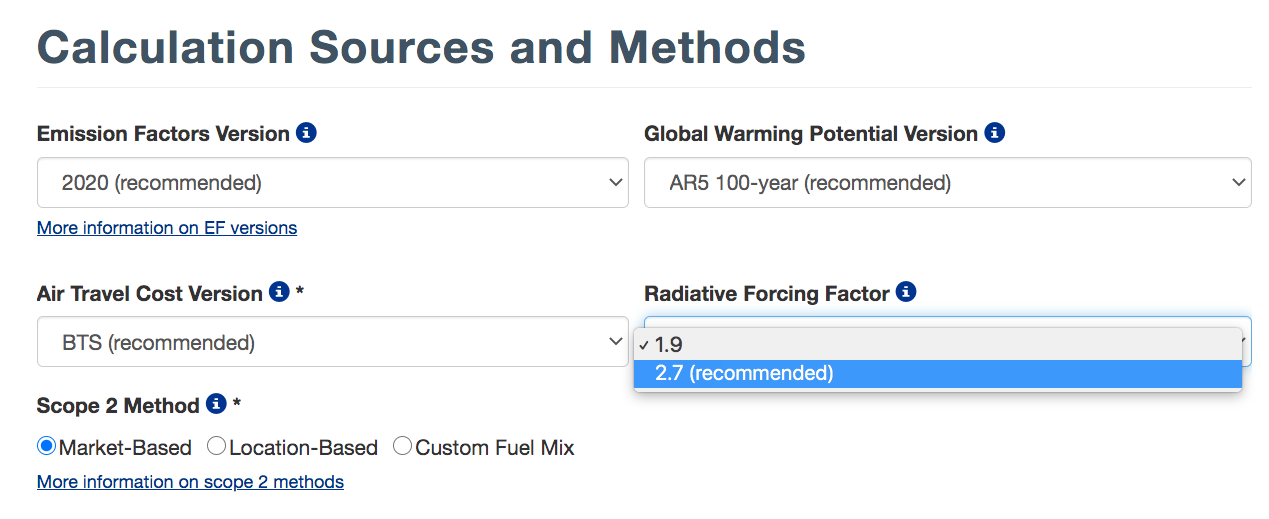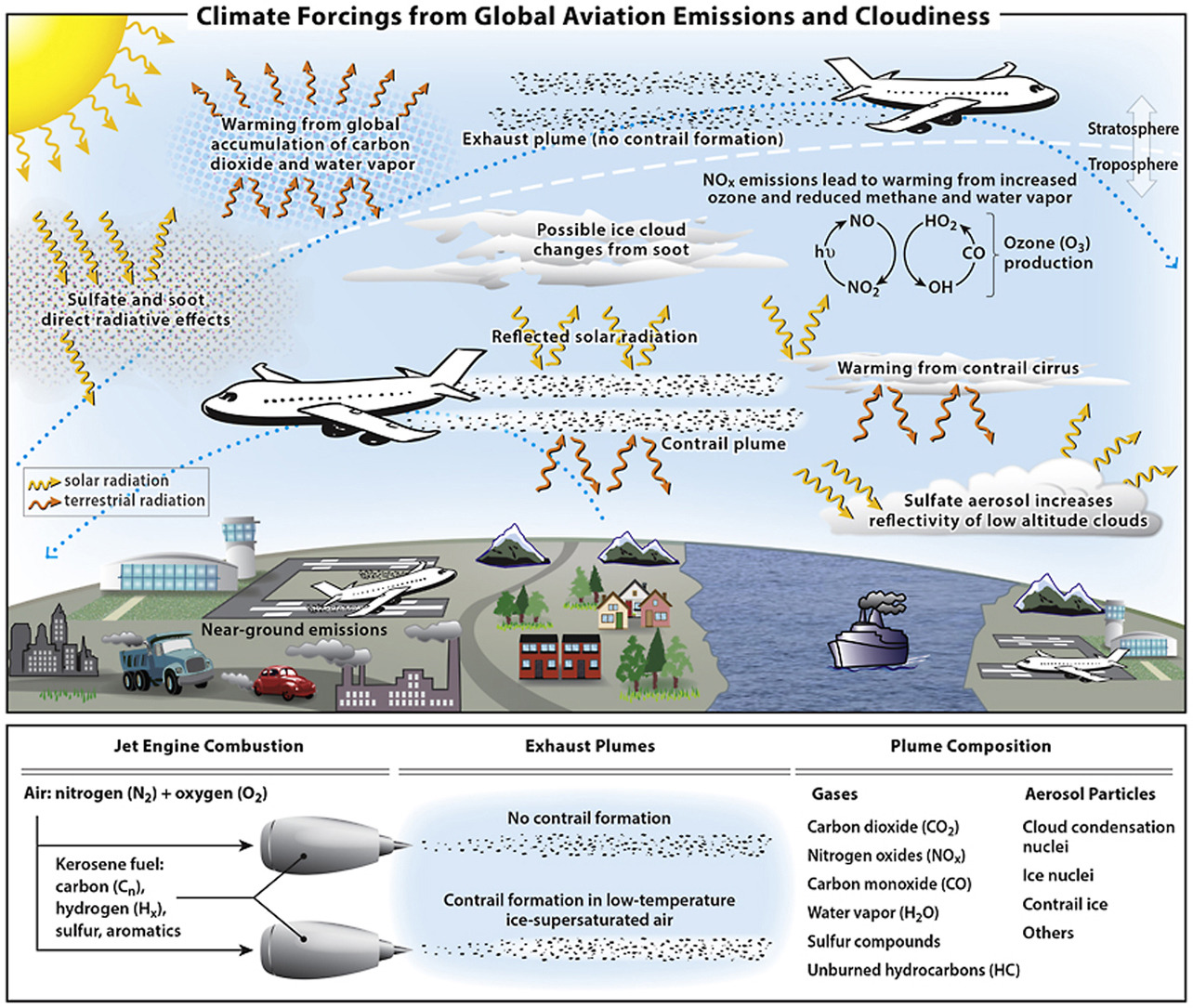RADIATIVE FORCING FACTOR
What is radiative forcing for air travel?
Radiative forcing is associated with emissions at higher altitudes and results in a higher global warming potential. Your air travel CO2 emissions are multiplied by the radiative forcing factor to account for the higher global warming potential from emissions released at higher altitudes. The radiative forcing factor is also sometimes referred to as the radiative forcing index.
Note: This figure describes more aspects of air travel emissions than are considered in SIMAP
Do air travel emissions in SIMAP include a radiative forcing factor?
Yes! SIMAP accounts for radiative forcing for all air travel CO2 emissions. To calculate your total air travel emissions, SIMAP multiplies the radiative forcing factor by the air travel emissions factor (see the emissions factors page). The SIMAP calculation is as follows:
Passenger miles * air travel CO2 emissions factor * radiative forcing factor
Please note that this is a change from the CCC, which had a radiative forcing factor of 2.7 built into the air travel emissions factor. In SIMAP, the multiplication by the radiative forcing factor is separate from the emissions factor and is hard-coded into the SIMAP calculations. However, the result will be the same. You can now select your radiative forcing factor (see below).
Can I customize the air travel radiative forcing factor?
Radiative forcing varies greatly depending on a number of variables (e.g., altitude, trip length), and estimates are still being refined. For that reason, GHG calculation tools and models vary widely in whether they include radiative forcing factors at all, and what those factors are. This is why we have updated SIMAP to allow users to select their radiative forcing factor. You can now select your radiative forcing factor on the Data Mgmt tab, following the January 2021 functionality updates. Radiative forcing factors in the literature vary from 1.9 - 3.4. Previously, SIMAP used a standard factor of 2.7, which is based on IPCC data. We continue to recommend this factor because it is more conservative. However, you now also have the option to select the radiative forcing factor that the UK-based DEFRA recommends (1.9).

Note: As of 2023, SIMAP is no longer updating the passenger yield $/mi conversion methodology described below. Instead, see the purchasing data entry page for more information on entering dollars spent.
How does SIMAP convert air travel dollars into passenger miles?
SIMAP uses national statistics on air travel cost and miles traveled to calculate average $/mi. We now offer the ability to select your air travel $/mi conversion factor because there are two data sets: An outdated data set that is no longer available, and a new data set directly from the Bureau of Transportation Statistics that is up to date. We recommend using the BTS version.
The outdated version of $/mi did not include taxes, whereas the updated BTS version does include taxes. This means that the new $/mi conversion factor is higher, which results in lower air travel miles (and air travel emissions). However, we think this update will be more accurate since most campuses include taxes in their air travel dollars spent. In addition, the new data set will continue to be available in future years.
If I have my air travel data in both $ and passenger miles, which should I enter?
When available, we recommend entering air travel data in passenger miles. The conversion factor from dollars to miles introduces increased uncertainty to the calculation because the $/mi conversion factor can vary significantly based on the length of the trip and the origin and destination. However, if air travel passenger miles are not available, then entering your air travel data in dollars will still provide a reasonable estimate of your air travel emissions.
Can I enter other directly financed travel data in dollars?
No, it is not yet possible to enter other directly financed travel data (e.g., taxi, personal car reimbursement) in miles. If you have directly financed travel data sets in dollars, then you could look up a $/mi conversion factor online to convert your data set into miles. If you use this approach, we suggest that you carefully document your conversion factors and data sources in the notes section for the relevant data entry.
Air travel cost version ($/mi) data sets
Conversion factors for the two versions of the air travel passenger yield ($/mi) conversion factors: Bureau of Transportation Statistics (BTS) (Recommended) and Pre-2020 (Out of date)
|
Year |
BTS Version (recommended) |
Pre-2020 Version (out of date) |
| Cents per mile | Cents per mile | |
| 1990 | 15.29 | 12.70 |
| 1991 | 15.29 | 13.06 |
| 1992 | 15.29 | 12.86 |
| 1993 | 15.29 | 13.36 |
| 1994 | 15.29 | 13.07 |
| 1995 | 15.29 | 13.51 |
| 1996 | 15.29 | 13.48 |
| 1997 | 15.29 | 13.48 |
| 1998 | 15.29 | 13.38 |
| 1999 | 15.29 | 13.07 |
| 2000 | 16.06 | 13.36 |
| 2001 | 16.06 | 12.32 |
| 2002 | 16.06 | 11.56 |
| 2003 | 16.06 | 11.70 |
| 2004 | 16.06 | 11.77 |
| 2005 | 16.06 | 12.18 |
| 2006 | 16.06 | 12.99 |
| 2007 | 16.06 | 13.32 |
| 2008 | 16.06 | 14.12 |
| 2009 | 16.06 | 12.22 |
| 2010 | 16.32 | 13.63 |
| 2011 | 17.78 | 14.89 |
| 2012 | 18.67 | 15.38 |
| 2013 | 19.08 | 15.29 |
| 2014 | 19.87 | 14.45 |
| 2015 | 19.12 | 12.73 |
| 2016 | 18.73 | 14.16 |
| 2017 | 18.56 | 14.16 |
| 2018 | 18.68 | 14.16 |
| 2019 and following years | 18.88 | 14.16 |


